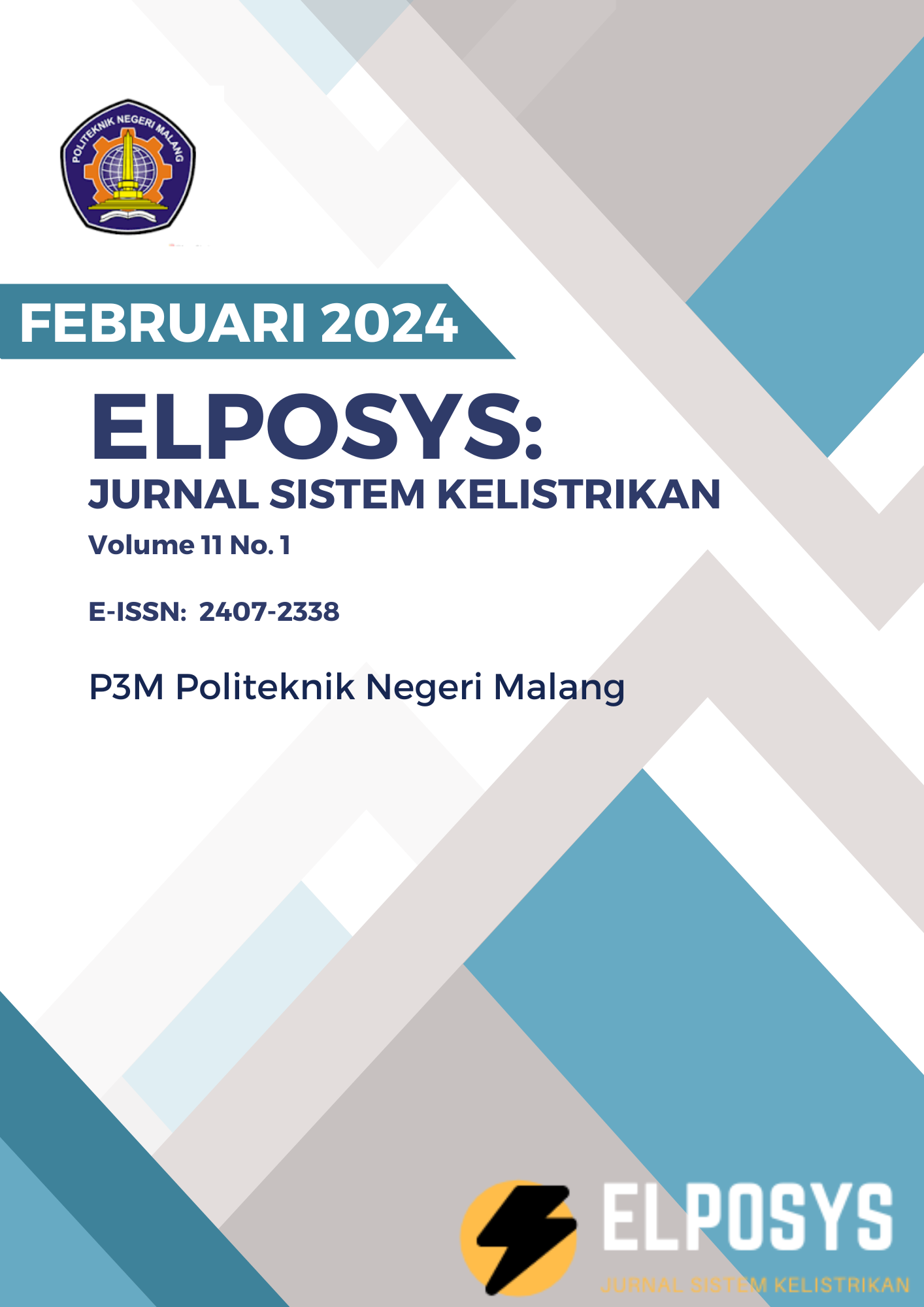Rancang Bangun Akuarium Dengan Pengkondisian PH Air Otomatis Berbasis PLTS
DOI:
https://doi.org/10.33795/elposys.v11i1.4892Keywords:
: PLTS, PH, Automatic feed.Abstract
Many people in Indonesia keep freshwater ornamental fish, including guppy fish (Poecilia reticulata), green growth fish (Gyrinocheilus aymonieri), neon tetra fish (Paracheirodon innesi). Neon tetra fish are popular because of their distinctive striking and bright body lines, while guppy fish are kept because of their ease of care and beautiful color variations, especially in male guppies. Guppy fish can grow well at temperatures of 22°C - 27°C and pH 6.5-7.2. Because managers are busy, this becomes an obstacle in fish cultivation, because the water quality that determines fish development becomes unstable. The results of the PLTS output test for 7 days 7 hours per day from 09.00 – 15.00 WIB can charge the battery with an average voltage of 13.89 V and an average current of 1.2 A and an average power of 14.15 W and can run for 24 hours. O'clock. Testing the battery for 7 days and 7 hours from 09.00 – 15.00 WIB can meet power needs for 24 hours with an average battery voltage of 13.36 V and an average current of 0.71 A. Meanwhile, the test results for the servo motor with a feed weight of 2, 45 grams and a servo motor delay of 2 seconds. Testing the pH of the water using a pH pump showed a change from the initial value of 8.06 to 6.91 and was measured with the PH4502C sensor. Tests without a PH pump showed an increase in changes from the initial pH value of 7.76 to 8.05.
References
Pradypta, L. Anifah, N. Kholis, and F. Baskoro, “Rancang Bangun Sistem Monitoring pH Dan Kontrol Suhu Pada Media Pemeliharaan ikan Hias Air Tawar,” J. Tek. Elektro, vol. 11, no. 2, pp. 270–277, 2022.
S. I. Matondang and A. Yanie, “Rancang Bangun Alat Pemberi Makan Ikan Otomatis Berbasis Arduino,” J. Electr. Technol., vol. 7, no. 2, pp. 47–53, 2022.
A. F. U. Suduri, S. I. Haryudo, Joko, and M. Widyartono, “Rancang Bangun Pembangkit Listrik Tenaga Surya Kapasitas 80 Wp Untuk Alat penetas Telur Berbasis IoT,” J. Tek. Elektro, vol. 10, no. 3, pp. 587–596, 2021.
L. Ruhyana, F. U. Albab, and G. P. Ramdhani, “Rancang Bangun Prototype Pembangkit Listrik Tenaga Surya Untuk Sistem Penerangan Rumah,” J. Fak. Tek., vol. 3, no. 3, pp. 97–100, 2022.
R. W. Mahendra, E. Setiawan, and R. Maulana, “Sistem Pengendali Kualitas Air untuk Budidaya Ikan Guppy berdasarkan Suhu dan Derajat Keasaman Air menggunakan Metode KNN ( K-Nearest Neighbor ),” J. Pengemb. Teknol. Inf. dan Ilmu Komput., vol. 6, no. 1, pp. 473–481, 2022.
A. G. Putra, I. Hidayat, and S. Sumaryo, “Realisasi Sistem Kendali Akuarium Otomatis Pada Pemeliharaan Ikan Hias Air Tawar,” e-Proceeding Eng., vol. 6, no. 3, pp. 10128–10137, 2019.
A. N. Roby and M. F. Maula, “Sistem Kontrol Lampu Otomatis Pencegah Hama Berbasis Panel Surya dan Mikrokontroler,” JILPI: Jurnal Ilmiah Pengabdian dan Inovasi, vol. 2, no. 1, pp. 67–74, 2023.
A. I. Darmansyah, A. Sumardiono, E. Alimudin, and M. Rahayu, “Tempat sampah otomatis berbasis Internet of Things dengan penyulangan hybrid PV-grid: Automated trash bin based on Internet of Things with PV-grid hybrid feed,” JITEL (Jurnal Ilmiah Telekomunikasi, Elektronika, dan Listrik Tenaga), vol. 1, no. 2, pp. 189–200, 2021.
A. Setiawan and R. I. Vidyastari, “Perancangan Alat Pemberian Pakan dan Minum Ayam Broiler Secara Otomatis Menggunakan Notifikasi Blynk,” Digital Transformation Technology, vol. 3, no. 1, pp. 185–191, 2023.
K. A. Wibisono and E. D. Cahyono, “Rancang Bangun Monitoring pH Meter Digital Berbasis Interface Delphi 7,” Nucleus Journal, vol. 1, no. 1, pp. 12–20, 2022.
M. al Husaini, A. Zulianto, and A. Sasongko, “Otomatisasi Monitoring Metode Budidaya Sistem Hidroponik dengan Internet of Things (Iot) Berbasis Android MQTT dan Tenaga Surya,” Jurnal Sosial dan Teknologi, vol. 1, no. 8, pp. 785–800, 2021.
D. Harsono and J. Sunardi, “SIMULASI KENDALI PROSES PEMURNIAN NIRA MENTAH MENGGUNAKAN DCS SIMULATOR PANEL STTN-BATAN,” in Prosiding Seminar Nasional Terapan Riset Inovatif (SENTRINOV), 2022, pp. 223–230.
H. D. F. Amaral, D. N. Akbar, and A. Zuroida, “Rancang Bangun Sistem Pemberian Pakan Ikan Lele Otomatis Berbasis Mikrokontroler,” ELPOSYS: Jurnal Sistem Kelistrikan, vol. 9, no. 3, pp. 179–182, 2022.
M. F. Hakim, I. Ridzki, and B. I. Kurniawan, “Pemasangan Lampu Sorot dan Led Strip Dengan Pengoperasian Otomatis di Gapura Klaster SPI Sukun Kota Malang,” ELPOSYS: Jurnal Sistem Kelistrikan, vol. 8, no. 1, pp. 46–50, 2021.
E. Tarigan, “Technical, economic and environmental analysis of residential scale of the rooftop PV system in Surabaya, Indonesia,” in IOP Conference Series: Earth and Environmental Science, IOP Publishing, 2020, p. 012004.
Downloads
Published
How to Cite
Issue
Section
License
Copyright (c) 2024 Elposys: Jurnal Sistem Kelistrikan

This work is licensed under a Creative Commons Attribution-NonCommercial 4.0 International License.








